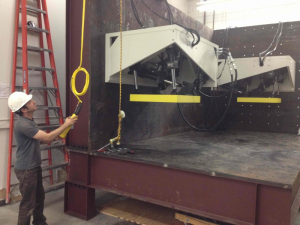New, stronger concrete that can better withstand an earthquake isn’t much good if it’s too expensive to use.
That’s the idea behind a research project being conducted by Bora Gencturk, assistant professor of civil and environmental engineering in the University of Houston Cullen College of Engineering. Gencturk recently won a two-year, $175,000 BRIGE award from the National Science Foundation to study ways to selectively use high-performance fiber-reinforced concrete (HPFRC) in buildings.
These types of concrete are made with fibers of polymer or steel, which give the material extra strength and ductility, and make it more likely to survive an earthquake without suffering major damage. While that’s clearly desirable, the fibers also drive up the price of concrete substantially, limiting the materials’ practical uses.
“In most cases, it would be too costly to use high-performance concrete for an entire building,” said Gencturk. “On average, the material is about three to five times more expensive than normal concrete. It’s difficult to convince people to invest that much more money.”
His alternative: use high-performance concrete only at those spots where a structure is likely to fail. This approach, he said, could help limit construction costs while reaping the benefits of advanced materials.
Specifically, he is exploring how to use HPFRC at the joint regions of horizontal beams and vertical columns. “We have seen in recent earthquakes that the beam-column joints in concrete structures are still a problem. We see a lot of failures, especially premature failures, at these connections,” he said.
To conduct this work, Gencturk is relying on two pieces of equipment that few groups have access to, even in the world of structural engineering research.
The first is a multi-axial testing system. The heart of this system is a loading platform where a concrete column or beam can be attached. The platform itself is connected to a series of pistons that allow it to shift the beam or column in practically any direction. With this tool, Gencturk can very accurately simulate the types of loads beam-column joints are exposed to during an earthquake.
The second tool is a non-contact digital image correlation system. With this system researchers basically coat concrete (or any other material) with a speckle pattern. They then test how the material holds up to different loads while filming it with two separate cameras. By using individual speckles as reference points, they can then match up images from the two cameras to answer questions about material failure, such as where cracks occur and how they grow.
Combined, these two systems will allow Gencturk to study exactly how beam-column joints made with HPFRCs withstand different loads during earthquakes. Though this grant is his first in what will hopefully be a series of awards on this topic, Gencturk believes this work could lead to design specifications for the use of high-performance concrete at beam-column joints.
“This grant still focuses on the fundamentals of the problem. We’re still trying to improve our understanding of joint behavior in reinforced concrete buildings. But if we can learn how to use high-performance concrete at the spots where structures are most vulnerable, we may be able to improve their strength dramatically without adding too much to the final cost,” he said.
